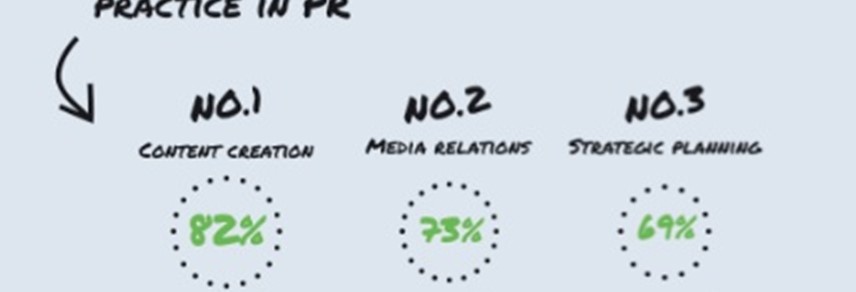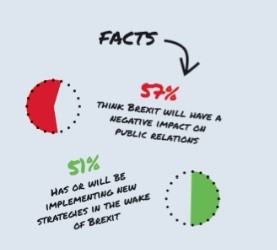
PLAN AND DELIVER
With a changing landscape for trust and credibility, the role of public relations is becoming more important than ever. How is PR changing to meet these new challenges? Kirsty Fraser investigates
A n ever-connected digital landscape and recent political change have widened the
traditional terrain for public relations.
Known to embrace innovation in times of uncertainty, the industry is, once again, rising to the challenge. Social media has changed the pace of conversation
about brands. Now that simple tweets and hashtags can undermine a company’s reputation and have opened the floodgates for damage control, PR is evolving into a more proactive, rather than reactive, discipline. In a time of ‘fake news’ and damaged credibility for government and media outlets amid political upheaval –Britain’s exit from the European Union and the election of US President Donald Trump – PR has to respond and rebuild trust in the business world.
The Chartered Institute of Public Relations (CIPR), the professional body for public relations practitioners in the UK, released the eighth iteration of its annual #StateOfPR study. The research shows a 10% rise from 2016 in the number of industry professionals spending time on strategic planning.
Phil Morgan, deputy chief executive at the CIPR, welcomes this news and hopes it will contribute to an increased reputation of PR. “This is quite a step forward for us, and we think that’s the direction we want the profession to take,” says Morgan. “Strategic planning is what is going to push us up the value chain and will help us meet future threats.”

Mynewsdesk, a Swedish multimedia platform, in partnership with Stockholm-based Berghs School of Communication, conducted a study in 2016 into the changing role of the PR professional in the digital revolution. The study, which surveyed over 2,500 professionals in eight countries, found that over 85% expect there to be an increased focus on PR technology over the next five years, and 63% believe their roles will become more strategic. This rise of strategic planning is an apparent shift from PR’s origins as a tactical field founded in agencies relationships to the press. Adopting a more strategic mindset and incorporating a focus on long term business objectives, the practice has taken on an approach that can influence boardroom level decision making.
The CIPR’s study reveals that strategic planning is now the third most common task for PR practitioners, following close behind content creation (82%) and media relations (73%). PR was once rooted in media output, but the perception of PR is advancing, Morgan says, as the field is becoming more knowledge based.
With emerging technologies and changing preferences on how content is consumed, there is also a move to corporate storytelling with an increased focus on visual content. According to the CIPR’s research, this is illustrated with a 7% rise in PR professionals devoting time to photo and video creation. As video becomes more ubiquitous, Morgan says, and the technology behind it becomes easier and cheaper to use, it is a fitting response to “the changing fashions and needs within content creation.”
While there is an increased need for multimedia content, public affairs and lobbying is also on the rise, 6% from 2016, and perhaps a response to a more volatile political climate, Morgan says. The UK’s vote to leave the EU sent shock waves across the industry and had PR practitioners reeling. According to the CIPR’s study, 57% believe that Brexit would have a negative impact, but over half have already or will implement new strategies as a result of the vote. Morgan expects organisational change to increase as the situation surrounding the UK’s departure becomes more clear.
“We sense there is a tremendous opportunity in Brexit because of the need for businesses to navigate this uncertainty and the need to bring knowledge in,” says Morgan. “Public relations people traditionally have that role; they bring the outside world in to organisations. So if they are working for their clients, or if they’re in-house working for their employers, they could be bringing in vast amounts of knowledge and helping the organisations assimilate that knowledge into their strategies and helping them rebuild relationships.”
The initial dread that may have followed the wake of Brexit has abated as PR practitioners see increased optimism for the future, as well as increased budgets and business. Public trust in four key institutions – business, government, media and NGO – has dropped, according to the 2017 Edelman Trust Barometer, conducted by Edelman, a US-based public relations firm. Media has seen a sharp decline to 43% and is at an all-time low across 17 countries, with the firm citing the phenomenon of fake news and perceived ‘elitism’ of media outlets.
Businesses however, while on this brink of distrust, can recover if they implement the right communications strategies. As distrust of media and government is likely to continue in the current political climate, it is the role of PR professionals to rebuild relationships for businesses.
PR as an industry has never shied away from change, in fact, it has welcomed it with open arms. While the coming years are filled with ambiguity – the evolving role of the PR professional ushered in by the digital revolution and the unfolding of Brexit – it is in uncertainty that PR professionals adapt, and rise, as communicators.




